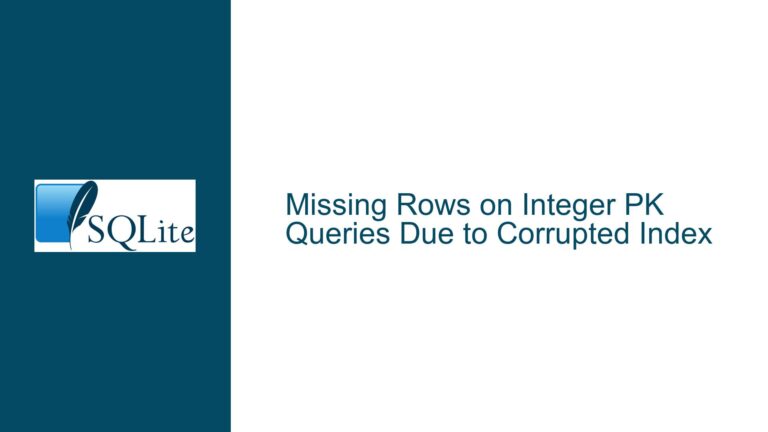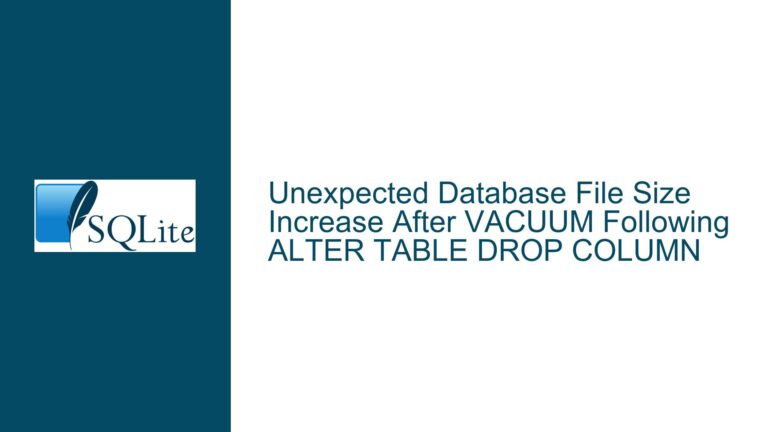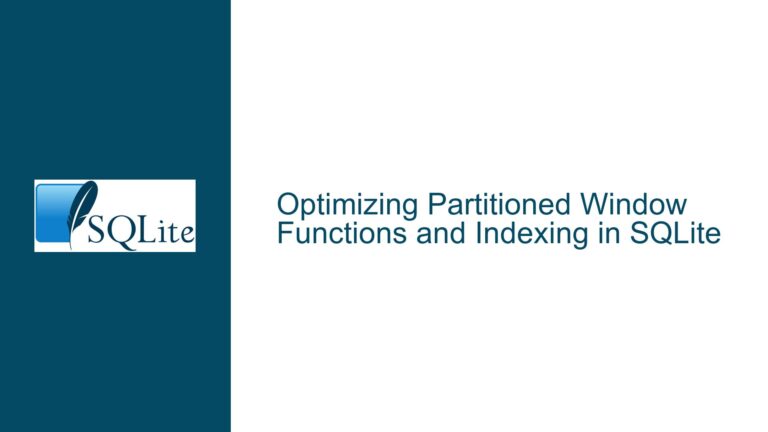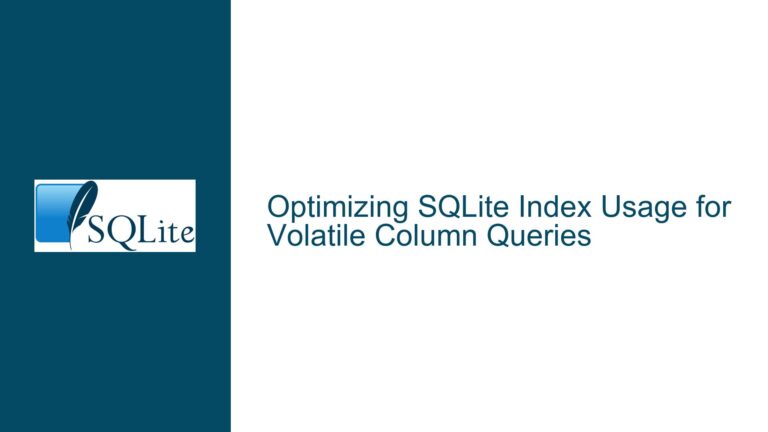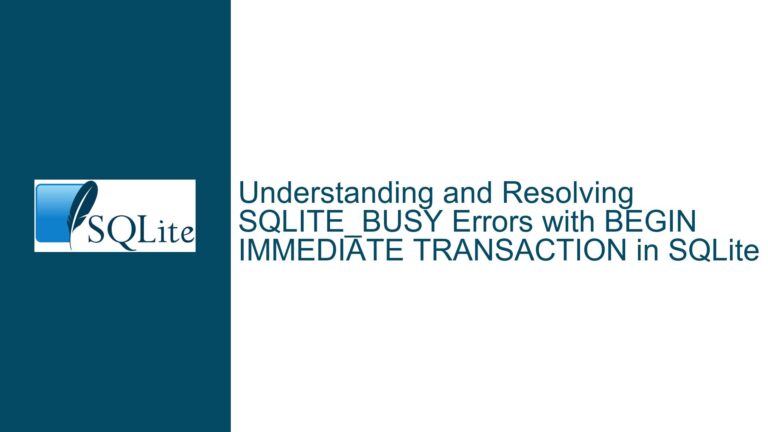Optimizing VACUUM in WAL Mode: Reducing I/O Overhead in SQLite
Understanding VACUUM in WAL Mode and Its I/O Implications
The VACUUM command in SQLite is a critical operation for reclaiming unused space and optimizing database performance. When operating in Write-Ahead Logging (WAL) mode, the behavior of VACUUM introduces significant I/O overhead, particularly for large databases. In WAL mode, SQLite writes the entire contents of the database three times during a VACUUM operation: once to a temporary file, once to the WAL file, and finally to the main database file. For a 600 GB database, this results in 1800 GB of total writes, which can be prohibitively expensive in terms of disk I/O and time.
The core issue lies in the way SQLite handles the VACUUM operation in WAL mode. Unlike regular transactions, which leverage the WAL file for efficient in-place updates, VACUUM does not utilize the WAL file in the same manner. Instead, it creates a temporary file to store the compacted database, logs the changes in the WAL file, and then commits the changes to the main database file. This three-step process is necessary to ensure data integrity and consistency but comes at the cost of increased I/O operations.
The question arises: why can’t SQLite use the WAL file directly for VACUUM operations, similar to how it handles normal transactions? Since SQLite version 3.11, pages in the WAL file can be rewritten in-place, which suggests that there might be a way to optimize VACUUM operations by leveraging this capability. However, as Richard Hipp points out, implementing such a change would require significant modifications to the SQLite codebase, including the addition of special-purpose code and extensive testing. This would increase the size of the SQLite library and potentially slow down VACUUM operations for smaller databases that can fit entirely in memory.
Exploring the Constraints and Trade-offs of VACUUM in WAL Mode
The inefficiency of VACUUM in WAL mode stems from several underlying constraints and trade-offs in SQLite’s design. First, SQLite prioritizes data integrity and consistency above all else. The three-step process of writing to a temporary file, logging in the WAL file, and committing to the main database file ensures that the database remains in a consistent state even in the event of a crash or power failure. This approach is particularly important for large databases, where the risk of data corruption is higher due to the sheer volume of data being processed.
Second, SQLite’s architecture is designed to be lightweight and portable, with a focus on simplicity and reliability. Introducing a new mechanism for VACUUM operations that leverages the WAL file directly would add complexity to the codebase, increasing the risk of bugs and making the library harder to maintain. Additionally, the benefits of such a change would be limited to a specific use case—large databases that require frequent VACUUM operations—while the drawbacks, such as increased library size and potential performance degradation for smaller databases, would affect all users.
Third, the current implementation of VACUUM in WAL mode is optimized for the common case where the database is small enough to fit in memory. In this scenario, the temporary file used during VACUUM is kept in memory, minimizing I/O overhead. However, for large databases that exceed available memory, the temporary file must be written to disk, resulting in the observed I/O inefficiencies. While it might be possible to optimize VACUUM for large databases by leveraging the WAL file, doing so would require careful consideration of the trade-offs involved, including the impact on memory usage, performance, and code complexity.
Strategies for Mitigating I/O Overhead in VACUUM Operations
While the current implementation of VACUUM in WAL mode has its limitations, there are several strategies that database administrators and developers can employ to mitigate I/O overhead and improve performance. These strategies range from optimizing database design to leveraging external tools and techniques.
One approach is to minimize the need for VACUUM operations by adopting best practices for database design and maintenance. For example, using appropriate data types, avoiding excessive use of NULL values, and regularly analyzing and optimizing indexes can help reduce fragmentation and unused space in the database. Additionally, using the AUTOINCREMENT keyword sparingly and avoiding unnecessary row deletions can help maintain a compact database structure.
Another strategy is to partition large databases into smaller, more manageable files. By splitting the database into multiple files based on logical or temporal criteria, it becomes possible to perform VACUUM operations on individual partitions rather than the entire database. This reduces the amount of data that needs to be processed during each VACUUM operation, thereby minimizing I/O overhead.
For databases that require frequent VACUUM operations, consider using a custom script or tool to automate the process. For example, a script could monitor the database for fragmentation and trigger a VACUUM operation only when necessary, based on predefined thresholds. This approach ensures that VACUUM operations are performed efficiently and only when needed, reducing the overall impact on system resources.
In cases where the I/O overhead of VACUUM operations is unacceptable, consider using an alternative database system that is better suited to the specific requirements of the application. While SQLite is an excellent choice for many use cases, other lightweight databases, such as DuckDB or LiteDB, may offer better performance for large datasets or specific workloads. When evaluating alternative databases, consider factors such as data integrity, ease of use, and compatibility with existing tools and applications.
Finally, for developers who are comfortable with modifying the SQLite source code, it may be possible to implement a custom optimization for VACUUM operations in WAL mode. This would involve adding support for direct WAL file usage during VACUUM, as suggested in the original discussion. However, this approach requires a deep understanding of SQLite’s internals and should only be attempted after careful consideration of the potential risks and trade-offs.
In conclusion, while the current implementation of VACUUM in WAL mode introduces significant I/O overhead for large databases, there are several strategies that can be employed to mitigate this issue. By optimizing database design, partitioning large databases, automating VACUUM operations, and considering alternative database systems, it is possible to achieve a balance between performance and data integrity. For those with the necessary expertise, custom modifications to the SQLite source code may offer additional opportunities for optimization. However, any changes should be approached with caution, keeping in mind the trade-offs involved and the potential impact on the overall stability and reliability of the database system.

